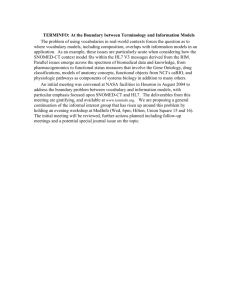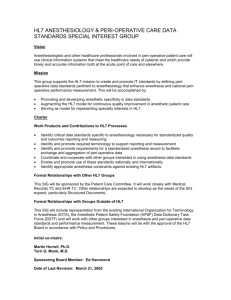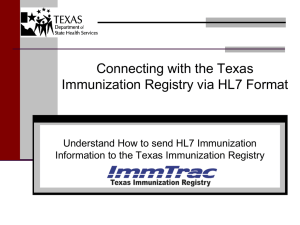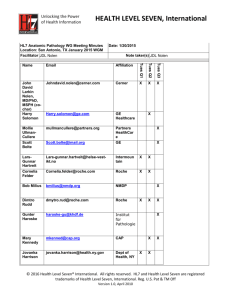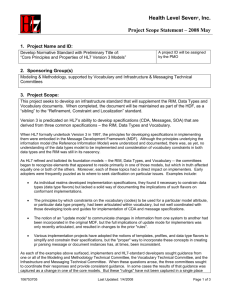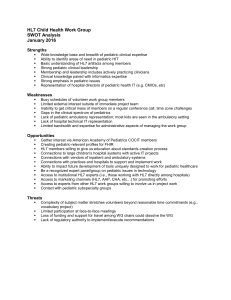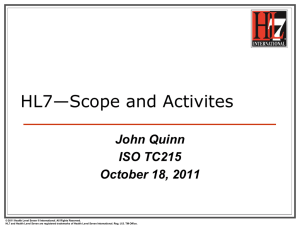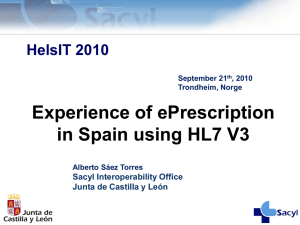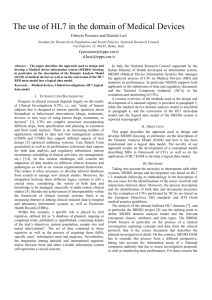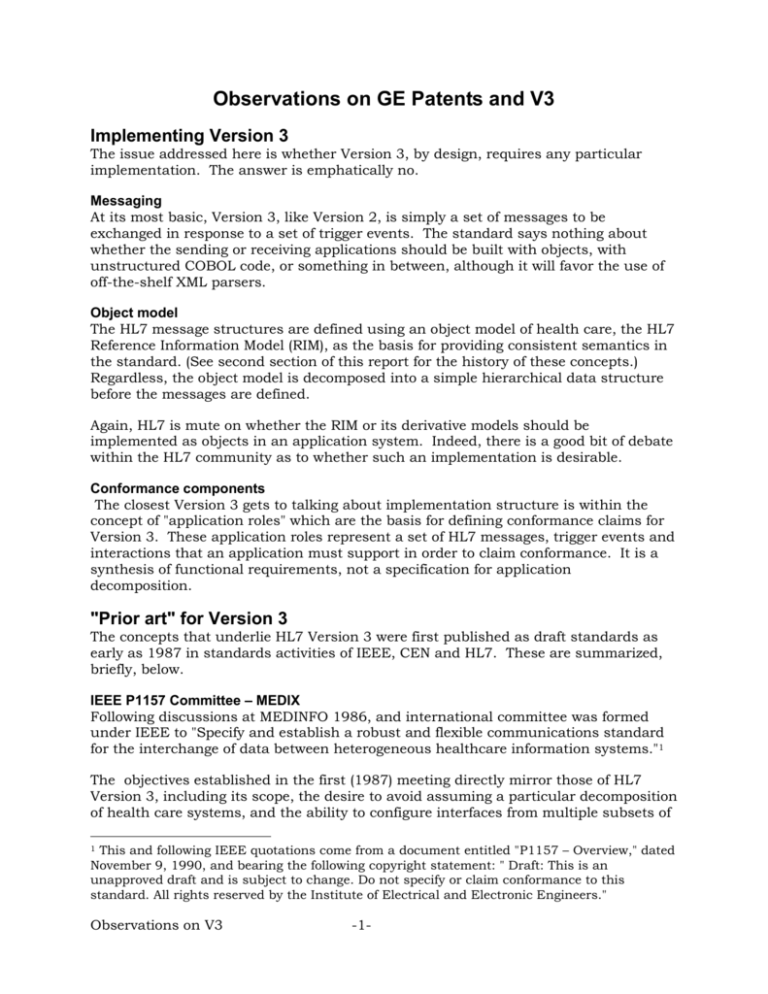
Observations on GE Patents and V3
Implementing Version 3
The issue addressed here is whether Version 3, by design, requires any particular
implementation. The answer is emphatically no.
Messaging
At its most basic, Version 3, like Version 2, is simply a set of messages to be
exchanged in response to a set of trigger events. The standard says nothing about
whether the sending or receiving applications should be built with objects, with
unstructured COBOL code, or something in between, although it will favor the use of
off-the-shelf XML parsers.
Object model
The HL7 message structures are defined using an object model of health care, the HL7
Reference Information Model (RIM), as the basis for providing consistent semantics in
the standard. (See second section of this report for the history of these concepts.)
Regardless, the object model is decomposed into a simple hierarchical data structure
before the messages are defined.
Again, HL7 is mute on whether the RIM or its derivative models should be
implemented as objects in an application system. Indeed, there is a good bit of debate
within the HL7 community as to whether such an implementation is desirable.
Conformance components
The closest Version 3 gets to talking about implementation structure is within the
concept of "application roles" which are the basis for defining conformance claims for
Version 3. These application roles represent a set of HL7 messages, trigger events and
interactions that an application must support in order to claim conformance. It is a
synthesis of functional requirements, not a specification for application
decomposition.
"Prior art" for Version 3
The concepts that underlie HL7 Version 3 were first published as draft standards as
early as 1987 in standards activities of IEEE, CEN and HL7. These are summarized,
briefly, below.
IEEE P1157 Committee – MEDIX
Following discussions at MEDINFO 1986, and international committee was formed
under IEEE to "Specify and establish a robust and flexible communications standard
for the interchange of data between heterogeneous healthcare information systems."1
The objectives established in the first (1987) meeting directly mirror those of HL7
Version 3, including its scope, the desire to avoid assuming a particular decomposition
of health care systems, and the ability to configure interfaces from multiple subsets of
This and following IEEE quotations come from a document entitled "P1157 – Overview," dated
November 9, 1990, and bearing the following copyright statement: " Draft: This is an
unapproved draft and is subject to change. Do not specify or claim conformance to this
standard. All rights reserved by the Institute of Electrical and Electronic Engineers."
1
Observations on V3
-1-
standard features. Like HL7 today, the MEDIX committee had a goal "of providing a
common reference model for convergence of existing standards," and asserted that
"The reference model for P1157 consists of a set of standardized objects which interact
through transactions."
For a variety of reasons, the IEEE P1157 committee did not complete the standards
envisioned, but during three years of on-going meetings, it did plant the seeds for
directly derivative developments in HL7 and CEN TC251 – Health Informatics. Indeed,
the following individuals who are active in HL7 today were listed as MEDIX
participants in 1990 - Tim Benson, Jack Harrington, Clem McDonald, George Beeler,
Stan Huff, Wayne Tracy, and Mead Walker.
CEN TC251 – Health Informatics
The CEN TC251 committee was formed in the early 1990s, and its mission statement
says, in part, "Standardization in the field of Health Information and Communications
Technology (ICT) to achieve compatibility and interoperability between independent
systems and to enable modularity. The CEN committee adopted a methodological
framework based upon the MEDIX framework, and advanced the art of this
methodology significantly. In particular, a project team report from CEN, authored by
Sigurd From of Norway, articulated the strategy for representing the information
represented in an object model as a hierarchical structure that can be readily
communicated as messages. CEN continues today to develop its message specification
using a same framework that is technologically identical to the Version 3 Framework.
Joint Working Group for a Common Data Model
In 1993, MEDIX, working under the auspices of the ANSI Health Informatics Planning
Panel (the predecessor to the Health Informatics Standards Board) convened the Joint
Working Group for a Common Data Model (JWGCDM). The JWGCDM drew its
participants from IEEE, HL7, ASC X12N, ASTM and DICOM. The goal of this group
was to establish a framework in which an object model of health care could be
developed and shared among the participating standards groups.
The JWGCDM produced two drafts of a framework document (1994 and 1996), before
the MEDIX committee dissolved. The JWGCDM framework became a central
component of the HL7 Message Development Framework.
HL7 Version 3
By 1995, the primary activity in the US related to the original MEDIX concepts was
the still-nascent Version 3 of HL7. This activity began to accelerate, producing the
following sequence of events:
1996 – Presented core concepts to a Technical Steering Committee retreat
1997 – Published first Message Development Framework (MDF) and the initial
Reference Information Model (RIM Version 0.84) in "mandatory" tutorials for the
HL7 Working Group
1998 – Published a revised and more complete methodology
1999 – Added the concept of Refined Message Information Model to the methodology
and incorporated the Unified Service Action Model concepts in the RIM
2001 – Published RIM, version 1.0, the first version not labeled "draft."
2001 – Published first comprehensive ballot of Version 3 material
Observations on V3
-2-
A few additional facts about HL7 Version 3, relative to the prior standards activities
are worth noting:
The concepts embodied in the HL7 Methodology are virtually the same as those
articulated by MEDIX and CEN TC251. This is by design and with permission
The RIM grew out of the synthesis over several years of models from multiple
sources, including several vendors and providers.
A core representation of the common HL7 and CEN methodology is being
balloted as an ISO standard through ISO TC 215.
The standards groups listed in this section have uniformly adopted object
modeling as the foundation for their work, and have (as they must) defined the
events in the health care environment that require communication.
Conclusion
The purpose of this paper is to lay out a set of facts relative to Version 3 from which
the readers may draw their own conclusions.
Observations on V3
-3-

